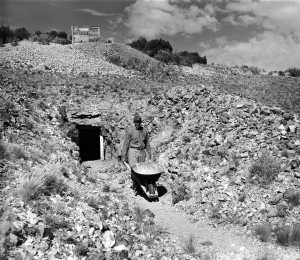 For as long as people have called New Mexico home, they have pulled gems and minerals from its soil. Today, that tradition yields oil, gas, coal, uranium, and always, the gems that decorate our jewelry. Primary among those gems is a a hydrated phosphate of copper and aluminum known worldwide as turquoise.
For as long as people have called New Mexico home, they have pulled gems and minerals from its soil. Today, that tradition yields oil, gas, coal, uranium, and always, the gems that decorate our jewelry. Primary among those gems is a a hydrated phosphate of copper and aluminum known worldwide as turquoise.
For that part of the story, head with us to the hills of Cerrillos, south of Santa Fe, where a once-vibrant mining district held a special allure to famed jewelry company Tiffany’s. All because of a particular type of turquoise and that fabled Tiffany Blue box.
The Cerrillos mining district has seen activity since 600 A.D., first from Native peoples, then Spanish colonists and, later, American mining companies. But the history of turquoise mining wasn’t always a cherished one. From the Cerrillos Hills web site:
During the Spanish Period the pueblos continued to mine turquoise for their own use and trade with the unconquered tribes around New Mexico. The Spanish considered turquoise worthless and laughed at the Indians for mining it. Consequently, Spanish documents … ignore the continued mining of turquoise by the Indians. Only a few Spanish documents even mention the continued use of turquoise by the pueblos.
Late 1800s documents make references to Santo Domingo and Cochito Puebloans traveling to the Cerrillos Hills to collect turquoise. With the arrival of the railroad in 1881 and the development of tourism, travelers began snapping up Pueblo turquoise jewelry. A fad was being born.
In 1889, George F. Kunz, Tiffany & Co.’s renowned gemologist, won an award in Paris for a collection that contained a sample of New Mexico turquoise. In 1892, Kunz announced that certain colors of turquoise had come to be considered “gem quality” – namely, the Tiffany Blue color.
 According to a New York newspaper: That is a turquoise far and away the finest in America, and it came from these new mines in New Mexico. It is worth $4,000. … (I)t is probable that gems to the value of $200,000 a year may be obtained from this mine. Kunz recognized the possibilities of further branding the Tiffany Blue color by maintaining almost-exclusive rights to the turquoise he had made suddenly valuable.
According to a New York newspaper: That is a turquoise far and away the finest in America, and it came from these new mines in New Mexico. It is worth $4,000. … (I)t is probable that gems to the value of $200,000 a year may be obtained from this mine. Kunz recognized the possibilities of further branding the Tiffany Blue color by maintaining almost-exclusive rights to the turquoise he had made suddenly valuable.
That year, James P. McNulty came to Cerrillos to mine turquoise, eventually landing with the American Turquoise Company, which owned the claims to a number of mines. The ATC sold almost all of its turquoise directly to Tiffany & Co., where designer Pauling Farnham (regarded by some as “Tiffany’s lost genius”) crafted some $2 million worth of it into jewelry.
McNulty died Jan. 26, 1933, and is buried in the Masonic section of the old cemetery on Cerrillos Road in Santa Fe.

Herculano Montoya at the Tiffany mine(1937). Palace of the Governors Photo Archives
Today, the Tiffany Mine and with five other mines in Cerrillos are owned by Doug Magnus, a Santa Fe jewelry designer whose Santa Fe 400th line is available in the Spiegelberg Shop at the New Mexico History Museum.
Magnus says the mines are, in all likelihood, played out. Still, he was able to obtain several specimens of the raw ore “that had been hoarded for 80 or 100 years by the man that did all the mining for the American Turquoise Company.”
Despite such difficulties, Magnus said, turquoise seems to be enjoying new verve. “I’ve been working with it since 1972, and I’ve watched it become the single most popular semi-precious gemstone in the realm of semi-precious gemstones. And that’s worldwide.”
Magnus will talk about the mines and about the use of turquoise in jewelry-making at the 5th annual Palace of the Governors Gem & Mineral Show, 9 am-5 pm, June 18-20, in the Palace Courtyard. The event is free via entrance through the Blue Gate south of the History Museum’s main entrance at 113 Lincoln Avenue.
Miners, merchants and jewelers will display (and sell!) specimens ranging from raw ore to polished finery.
Guest speakers at the event:
Garrick Beck, “The History of Fakery in Gemstones,” 11 am Saturday
Beck’s Santa Fe company, Natural Stones, specializes in genuine, natural stones that are not dyed, synthesized, “stabilized” or “enhanced.
Doug Magnus,”The Cerrillos Mines,” 2 pm Saturday
Magnus, a Santa Fe jewelry designer whose Santa Fe 400th line is available in the Spiegelberg Shop at the New Mexico History Museum, has owned the six mines in Cerrillos, N.M., including the fabled Tiffany turquoise mine, since 1988.
Sandy Craig,”The Opals of Ethiopia,” 1 pm Sunday
Craig’s Orca Gems and Opals of Littleton, Colo., carries specimens, rough, rubs and cut stones from Nevada, Mexico, Honduras, Ethiopia, Lightning Ridge, Lambina, Mintabi, Yowah and Koroit.
 The Gem & Mineral Show, in conjunction with the Palace of the Governors Native American Artisan Program, allows gem and mineral dealers and Native American artisans to tell their unique stories about the historical relationships that have existed between Native silversmiths and jewelers, miners, and gem and mineral traders.
The Gem & Mineral Show, in conjunction with the Palace of the Governors Native American Artisan Program, allows gem and mineral dealers and Native American artisans to tell their unique stories about the historical relationships that have existed between Native silversmiths and jewelers, miners, and gem and mineral traders.
Exhibitors will include: Garrick Beck; Orca Gems and Opals; Roadrunner Mining and Minerals; Bright Star Gemstones; and Will Steerman.
Come to look, come to touch, come to buy, but most important, come to learn more about the historic interplay between miners, mineral traders and the artisans who bring life to these fruits of the earth.

I always wondered about the Tiffany blue. I never knew that it was connected to turquoise.
I have a photo of Cerillos with the Tiffany store, bar, and maybe a bank. I assume they were all owned by the company? And what about the Tiffany, New Mexico, near Socorro – was that named after the jeweler or someone else? Inquiring minds want to know! Thanks in advance.
Well, Cathy, you’ve sent me on a mini-history tour trying to track this down–and I only got so far. Maybe some of our other history mavens out there can fill in the gaps?
Here’s what I’ve found out: The Tiffany Company was founded in 1837, and the Tiffany Mine became active in the late 1880s, early 1890s.
A book called “The Place Names of New Mexico” says the town was originally called Arny and consisted of “a cluster of corrals.” Later it says (while not saying when), the town became the site of the Diamond A Cattle Ranch run by “a Monsieur Tiffany.” (The town was flooded in 1929.)
Patricia Hewitt in the History Museum’s Fray Angelico Chavez History Library was able to find records of newspaper articles that referenced people named Tiffany in the Socorro area as early as 1885. (The newspapers themselves are long gone, however.) Those included an Isaac S. Tiffany and a J.C. Tiffany, who was president and manager of Bosque Bonito Ranches (perhaps that’s our “Monsieur”?). In 1888, the newspapers referenced an L.S. Tiffany, a lawyer in Socorro, and a Charles Tiffany, a member of the San Marcial Driving Park Association. Because these Tiffanys don’t appear to have been involved in mining, my best guess is that they’re different Tiffanys than the Tiffany Tiffany, if you catch my drift.
The state historian’s web site has an entry describing the development of Valverde, NM, from 1773 forward that mentions Tiffany Canyon and Tiffany Arroyo, and says the latter was “a name whose origin is in the 20th century.”
Thanks for the question, Cathy. Anyone else out there have some info about Tiffany, NM, that they’d like to share?
Hi again Kate,
I was motivated to look up Tiffany again after viewing an episode of Antiques Road Show! I found an obit in the New York Times for Col. Joseph C. Tiffany. It says he was, among other things, president of the Bosque Bonita Land and Cattle Company of San Marcial. He had sons Walton, Charles, and Joseph. He was the son of Comfort Tiffany of Baltimore. He was also Superintendent of Construction and agent for the Deming, Sierra Madre and Pacific Railroad. I still don’t know if he is related to the jeweler, but he might be.
How interesting. Good detective work!
I love turquoise jewelry, so it was interesting reading a little of its history!
Lewis Comfort Tiffany SON OF Charles Lewis Tiffany, Charles Lewis was the founder of Tiffany & Co., NY